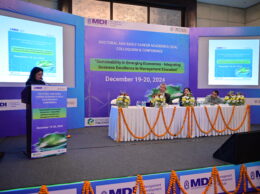The Indian Institute of Management Ahmedabad (IIMA) today launched a survey report titled ‘Digital Retail Channels and Consumers: The Indian Perspective,’ authored by Professor Pankaj Setia, IIMA Chair Professor, Professor of Information Systems and Strategy, and Chairperson of the Centre for Digital Transformation (CDT), Professor Swanand Deodhar, Associate Professor (Information Systems), IIMA and Mr. Ujjwal Dadhich, Research Manager, CDT. Highlighting the transformative impact of digital retail, the report offers crucial insights into its widespread adoption across India, empowering customers across different tiers of cities.
Delivering the inaugural keynote address, Professor Bharat Bhasker, Director, IIMA said, “We tend to think of online shopping as purely transactional. However, this meticulously crafted report delves into the emotional intricacies and diverse demographics that drive consumer behaviour online. The results and recommendations in this report will equip stakeholders with invaluable insights for shaping the future of e-commerce. Whether you’re a policymaker, a retailer, or simply curious about the evolving consumer landscape, this report offers valuable insights. I am intrigued by the findings, and I congratulate the Centre for taking up the initiative of putting out this report
The report includes findings from a consumer survey which recorded inputs from more than 35, 000 respondents from 25 states of the country from May to September 2022 and from a pilot enterprise survey with responses from 68 enterprise representatives, mostly located in and around Ahmedabad.
Speaking about how technology is revolutionising the online retail shopping experience, Professor Pankaj Setia, The IIMA Chair Professor, Professor of Information Systems and Chairperson, Centre for Digital Transformation, IIMA, said that in the retail sector consumer centricity is pivotal and digital channels have been instrumental in enhancing customer centricity by not only providing greater access to customers across geographies, but also by engendering and driving positive emotions.
In the report, the consumer survey findings are classified into four thematic areas – browsing behaviour, consumer spending, consumer preferences and perceived benefits and are presented below[1].
Browsing behaviour of consumers
- Browsing online has now become a favourite pastime for consumers, with one-third of consumers reported visiting digital retail platforms every two to three days
- Doing these activities, consumers invested an average of 34 to 35 minutes in their last online shopping.
- Nearly 72% of consumers started shopping online in the last one to three years, hinting at a surge during the COVID-19 pandemic.
Spending behaviour of consumers in the last online shopping transaction
- Consumers from smaller cities (Tier 2 to Tier 4 cities) spent up to 77% more than those from Tier 1 cities in their last online order.
- More than 90% of consumers reported spending less than ₹10,000 in their last online shopping transaction
- Nearly 65% of the surveyed consumers shopped products of only one product category (exclusive shopping basket) in their last online shopping transaction. Additionally, around 35% of consumers bought products of different categories together (mixed shopping basket).
- Shopping exclusively, consumers spent a per capita spending of INR 965 on fashion and clothing products, INR 4,309 on electronic products, and INR 1,848 on utility payments.
- Male consumers spent 36% more money than female consumers in their last online shopping transaction
- Nearly 65% of consumers used cash on delivery (CoD) to make payments in their last online transactions. The use of CoD was more prevalent to buy fashion and clothing products exclusively.
Preferences by gender, age, and income groups
- Female consumers shopped more for clothing and fashion products, whereas men shopped for electronic products.
- Female consumers reported realizing greater convenience from online shopping than male consumers
- Consumers under 24 years and those over 60 years reported realizing higher convenience scores from online shopping.
Motivators for increased online shopping
- Consumers prefer digital retail platforms due to the convenience of access and transaction, post-purchase experience, and value for money.
- Consumers from lower-income groups reported higher convenience and satisfaction scores.
- Overall, consumers reported an average score of 5 out of 7 when asked about the convenience derived from digital retail platforms. With a greater variety of services, products, and instant delivery time, Tier 1 city consumers reported having higher convenience and satisfaction scores than consumers of smaller cities.
The report goes beyond simply presenting its findings, offering actionable recommendations for retailers to retain new online shoppers, engage customers through targeted strategies based on demographics, and enhance satisfaction in smaller cities. By tailoring digital approaches to browsing behaviour, product categories, income segments, and even city types, retailers can cultivate active user bases and cater to diverse consumer preferences. This focus on personalization and adaptability positions online shopping for continued growth across India.
The report also includes findings from a pilot enterprise survey with a sample size of 68 enterprise representatives, most located in and around Ahmedabad. Some of the key findings from the survey include:
- Microscale of business and mode of doing business: Most enterprise representatives reported an annual turnover of less than INR 5 crores and around 76% enterprise reported doing both online and offline business, thus following an omnichannel strategy
- Using multiple channels to reach out to consumers: While doing business online, enterprises reported using multiple channels to reach out to consumers and increase sales. This included using multiple retail channels, social media, own websites, etc.
- Retailers incur a significant fee in doing business with digital retail channels: Majority of enterprise representatives reported paying a substantial component of fees to retail channels covering commission on sales, shipping fees, and transaction fees, among others.
- Increased sales through digital retail channels: More than half of the enterprise representatives reported that registering on online retail channels had led to increased sales
and additional income
[1] Please note that for the findings on the means, percentages, and other statistics presented in the report, we have not conducted any tests for statistical significance, and we do not attempt to generalize the findings beyond the sample of the survey.









